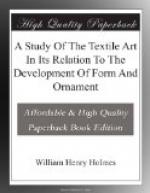Form in the textile art, as in all other useful arts, is fundamentally, although not exclusively, the resultant or expression of function, but at the same time it is further than in other shaping arts from expressing the whole of function. Such is the pliability of a large portion of textile products—as, for example, nets, garments, and hangings—that the shapes assumed are variable, and, therefore, when not distended or for some purpose folded or draped, the articles are without esthetic value or interest. The more rigid objects, in common with the individuals of other useful arts, while their shape still accords with their functional office, exhibit attributes of form generally recognized as pleasing to the mind, which are expressed by the terms grace, elegance, symmetry, and the like. Such attributes are not separable from functional attributes, but originate and exist conjointly with them.
In addition to these features of form we observe others of a more decidedly superfunctional character, added manifestly for the purpose of enhancing the appearance.
In very primitive times when a utensil is produced functional ideas predominate, and there is, perhaps, so far as its artificial characters are concerned, a minimum of comeliness. But as the ages pass by essential features are refined and elements of beauty are added and emphasized. In riper culture the growing pressure of esthetic desire leads to the addition of many superficial modifications whose chief office is to please the fancy. In periods of deadened sensibility or even through the incompetence of individual artists in any period, such features may be ill chosen and erroneously applied, interfering with construction and use, and thus violating well founded and generally accepted canons of taste. In respect to primitive works we may distinguish four steps in the acquisition of esthetic features of form, three of which are normal, the fourth abnormal: First, we have that in which functional characters alone are considered, any element of beauty, whether due to the artist’s hand or to the accidents of material, construction, or model, being purely adventitious; second, that in which the necessary features of the utensil appear to have experienced the supervision of taste, edges being rounded, curves refined, and symmetry perfected; third, that in which the functionally perfect object, just described, undergoes further variations of contour, adding to variety, unity, &c., thus enhancing beauty without interfering with serviceability; and, fourth, that in which, under abnormal influences, beauty is sought at the sacrifice of functional and constructive perfection.
[Illustration: Fig. 286. Mat or tray exhibiting a minimum of esthetic attributes of form. Moki work—1/8.]




